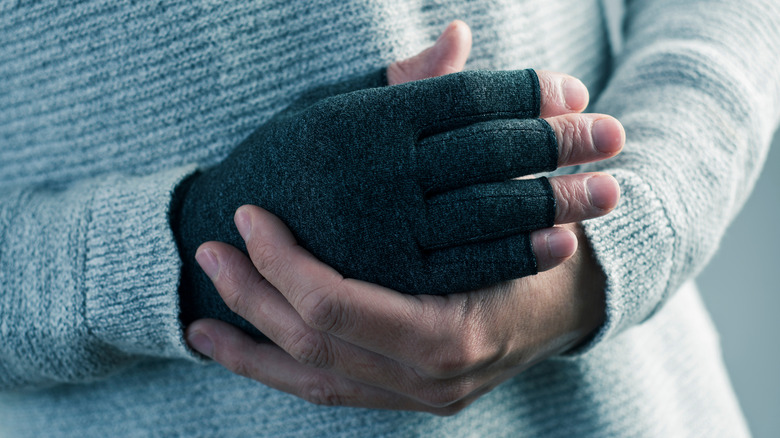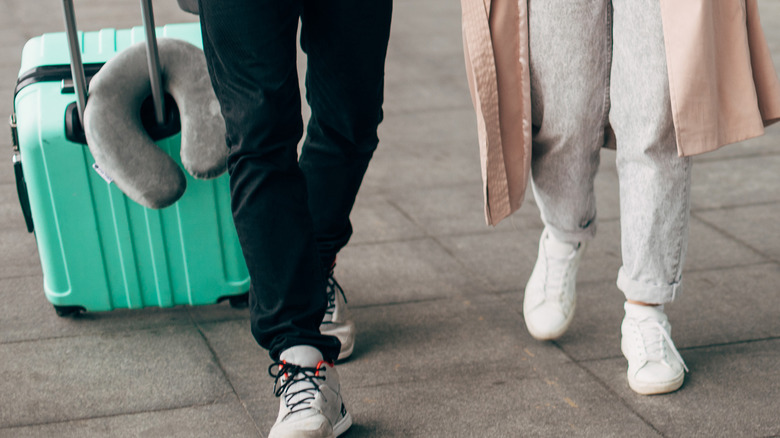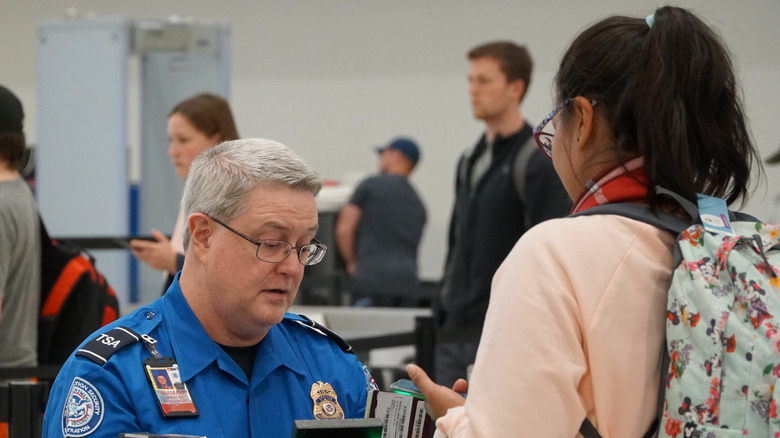How To Manage Rheumatoid Arthritis Symptoms When Flying And Traveling
If you have rheumatoid arthritis (RA), you might have noticed that your joints seem stiffer after a long car ride or a flight. According to the Mayo Clinic, inactivity can worsen RA-related joint stiffness. But that's just one of the numerous possible health concerns connected to this chronic inflammatory disorder.
A person with RA has an immune system that treats the cells of their body the same way it would dangerous viruses. In other words, it attacks the cells, and is particularly known for doing damage to the lining of the joints. So, it's not surprising that RA can also lead to joints throughout the body becoming tender and painfully swollen. Plus, as the Arthritis Foundation notes, pat-downs at airport security — even very gentle ones — can be painful for someone with RA. Additionally, a person with RA might experience fatigue, which can be especially problematic on any kind of trip.
Of course, if you have (or suspect you have) RA, make an appointment with a medical professional right away, so that you can manage your condition with the right medicine and treatment. What's more, having RA doesn't mean travel (or flying in planes) is off the table for you. Here are some ways that can help make your next trip a bit less stressful and more pleasant.
Plan ahead to minimize stress from traveling
Imagine you're asked to cook something you've never made before, but you're given no direction or even a list of ingredients. Now, imagine you're asked to cook that same meal, and are handed a detailed recipe. The second scenario sounds less stressful, right? Similarly, planning ahead can help someone with RA who's taking a trip. In fact, it might even reduce the chances of having RA-related health issues.
As WebMD explains, if you have RA, then stress can worsen your symptoms. And the prep work for a trip can be quite stressful, especially if you're trying to remember everything off the top of your head. This is where checklists can be very helpful. However, a RA patient should jot down more than just the usual travel items like travel documents and clothes, per Healthline. For example, they should include things like medications, as well as snacks that are good for RA. They also should make a pre-travel list of tasks to do before they leave, like refilling prescriptions and providing their hotel with their emergency contact's information.
Additionally, someone with RA might also want to think about possible issues that could come up and what to do about them. For instance, what can they do if they experience joint pain while on the plane? Is there something they can put in their carry-on bag that might help?
Talk to a medical professional beforehand
Maybe you were only recently diagnosed with RA, or maybe you've known about your RA for years. Either way, it's always a good idea to speak with a medical professional when you're planning to travel.
As Rheumatoidarthritis.net explains, letting your doctor know about your trip goes well beyond "I'm going away next month." For a rheumatologist or any healthcare professional to really help you prepare for your trip, you need to let them know important details, like how long your trip will be and where you'll go. You also want to let them know about any activities you're planning to do. By providing specifics about your trip, the two of you can come up with ways to avoid possible RA triggers like foods that contain refined sugars (which, according to ReumatoidArthrtis.org, might lead to inflammation). Other topics you can discuss include where you can get assistance while traveling, what activities might be bad for your RA, and how to schedule what you do want to do in such a way that you're less likely to have RA-related health issues.
In addition to helping you plan your trip, a medical professional can also write a prescription for you to take along on your trip just in case you need it (via Rheumatoidarthritis.net). In addition, they can give you a letter explaining your condition and treatments. You can also ask them if you need any additional insurance while traveling.
Get enough sleep before and during the flight
If you have RA, then sleep is especially important. As rheumatologist Dr. Rochelle Rosian told the Arthritis Foundation, "When you sleep, you make all those brain chemicals that you need to feel better. If you're not rested, you don't have all of these good hormones. So it may be more difficult to handle your pain."
Of course, sleeping on a plane isn't going to be like sleeping in your own bed. But that doesn't mean there aren't things you can do to make yourself more comfortable and increase the chances of getting some rest. CreakyJoints suggests booking a seat with extra leg room, ideally an aisle seat. Additionally, Dr. Maura Daly Iversen, professor of physical therapy and rehabilitation at Northeastern University in Boston, recommends asking for an extra pillow for back support. If you have elbow pain, you might want to put a blanket on your armrest. There are also inflatable pillows specially made for your neck.
Besides getting some sleep on the plane, you'll want to avoid falling into the trap of being too nervous to sleep the night before your flight. Try to finalize as much as you can for your trip well before you go to bed. Also, if you can, pick a flight time that won't be disruptive to your normal sleeping pattern.
Be careful about packing and storing medications
Of course, an RA patient shouldn't go on a trip without their medications. But as registered nurse Victoria Ruffing told WebMD, "RA medications can be fragile. If you pack them in your check-in luggage, temperature or pressure changes could potentially damage them."
According to Rheumatoidarthritis.net, one especially tough challenge can be traveling with a treatment for RA called injectable biologic medications. This is because this type of medicine needs to stay cold and should be kept in a refrigerator. Fortunately, there are insulated travel coolers where you can store not just your medication, but also the box your medication came in, your prescription information, and syringes. Besides a frozen ice pack, you can also put ziplock bags inside your cooler, just in case you need additional ice. And in case you're wondering, yes, you need to carry this cooler with you onto the plane rather than check it with your luggage.
Besides properly packing medications, you should find out ahead of time if your hotel room has a mini-fridge or a secure place with a fridge where you can properly store your temperature-sensitive medicine (via WebMD). But even if a hotel doesn't have either of these things, you can keep your medicine in an ice chest, per Rheumatoidarthritis.net. Finally, speak with a medical professional about traveling with your medications. They might have recommendations about travel cooler brands, for instance.
Pack RA-friendly snacks
While traveling is a chance to try new foods, it also can limit where and what you can eat. Take the airport, for example. Chances are there's only so many places near your gate to grab a snack — not all of which are necessarily the best choices for RA. But by planning ahead and bringing RA-friendly snacks, you can avoid this possible travel issue.
Of course, before you make any changes to your diet, you should speak with a medical professional not only about what you eat, but also proper portion control. For instance, as the Arthritis Foundation explains, walnuts contain large amounts of omega-3 fatty acids, making them a possibly good snack choice for a RA patient. But like other nuts, walnuts are high in calories, so you don't want to eat too many. Also, whole grain products like whole wheat crackers might help with inflammation. However, it's important to read the Nutrition Facts label on any product, since some manufacturers might use a combination of whole wheat, refined grains, added sugars, and/or saturated fats.
If you're craving something sweet, fruit might be a good option that could help reduce the chances of inflammation (via Arthritis Foundation). And according to Utah State University, arthritis patients might benefit from pomegranates, as well as berries like raspberries and blueberries. Other possible fruit options for RA include apples, pineapples, peaches, and strawberries.
Your vacation clothes can make a difference
For many people, it takes thought and planning to choose which clothes to bring on a trip. But for someone with RA, clothes can be a challenge. As RA patient Patty Harman told CreakyJoints, "I couldn't pull a shirt over my head or buckle a belt on my own. I couldn't even put on a bathing suit because I lost power in my hand."
RA can mean a little extra planning when packing for a vacation. For example, if you want to wear jeans, you should probably opt for a boyfriend fit rather than skinny jeans. As occupational therapist Dr. Lenore Salomon notes, it's better to have clothing that's looser-fitting, because it's easier to pull on during a RA flareup. Palazzo pants and sweatpants are also good options, as are pants with drawstrings or elastic waists. In addition, you might want to try leggings made from soft, stretchy fabrics.
Besides how tightly or loosely clothing fits someone, a RA patient should also explore tops and bottoms that don't have buttons, hooks, and other types of fasteners. For instance, a sports bra or a bra that fastens in the front instead of the back might be better options. Velcro or magnetic fasteners can also be easier for someone with RA. And if you do have a favorite shirt or outfit that buttons or zips, you might want to pack button hooks or zipper pulls.
Don't forget to bring non-medicine RA items
Without a doubt, medication is one of the most important things for someone with RA to bring while traveling. However, managing RA symptoms sometimes requires more than just medicine. And you might even find that you'll want to bring more of these non-medicine items with you when going away.
Keep in mind that not everyone with RA is going to need to bring the same items with them when traveling. Some RA patients, for example, find heat very therapeutic, and so they might pack heating pads and/or hand and foot warmers (via CreakyJoints). Others find ice helpful, and might prefer to bring ice packs on a trip. Still, others might find a combination of the two works best, and pack both. Other items an RA patient might want to consider include compression gloves and socks, splints, electric massagers, and special pillows. Also, even if you don't normally use an assistive device like a cane or a walker, you might want considering bringing one with you on a trip, just in case you walk more than usual.
As you can imagine, bringing extra items on a trip can mean heavier luggage, which might be bad for someone with RA. Opting for a suitcase with wheels can help. It's a good idea to push (rather than pull) these types of suitcases. Also, you might want to use either a backpack instead of a purse or a travel pouch around your neck.
Follow a healthy morning routine
For many RA patients, it's common to experience pain and joint stiffness as soon as they wake up in the morning (via WebMD). What's worse, that discomfort might not go away until at least an hour later. Now, for some, their usual schedule allows them to ease into the day. However, if you're trying to catch a flight, a train, a hotel shuttle, or any other trip-related transportation, this aspect of RA can be especially problematic. Fortunately, there are tips that might help.
For starters, drinking the right amount of water can help with joint stiffness. Staying hydrated throughout the day might reduce morning discomfort. Also, you might want to keep some water near your bed and sip it when you wake up to help managing stiffness. Furthermore, you might want to experiment with heat and cold therapy. For example, using an electric blanket as soon as you open your eyes in the morning might reduce early morning pain and stiffness. A warm shower can also be helpful, but WebMD recommends not staying in for more than 15 minutes.
In addition, there are simple life hacks that can help with RA symptoms during your self-care routine. As WebMD notes, putting rubber bands on your toothbrush's handle could make it easier to grip. Opting for an easy-to-maintain hair style can also take some pressure off the joints in your hands.
Work out before your flight
While there are a number of ways to help manage stiffness before you get out of bed, WebMD explains that sometimes, the best way to beat discomfort from RA is to get up and move. While this may seem like the last thing one wants to do when they're in pain and stiff, the right exercises can actually get one's blood flowing and make a difference for RA patients. What's more, these techniques might also help manage RA-related stiffness and discomfort while sitting in an airport and waiting for a flight.
As the American College of Rheumatology explains, the main types of exercises are 1) flexibility exercises like active range-of-motion and stretching exercises, 2) strengthening exercises, 3) aerobic exercises, and 4) body awareness exercises that help with things like balance, coordination, and relaxation. Technically, all of these can be good for someone with RA. However, WebMD recommends bending and straightening one's knees followed by gentle stretching exercises for morning discomfort. Just keep in mind that you don't want to overdo these exercises, especially if you're having a RA flareup. Also, walking can help as long as you start slow and go at your own pace. Remember, even just five minutes of walking might be beneficial.
Of course, before you start any exercise routine, you should speak with a medical professional like a rheumatologist (via American College of Rheumatology). In fact, this could be part of your pre-trip talk with them.
Communicate your needs to airport personnel
Sometimes it's not easy to tell someone — especially a complete stranger — about a health condition. For some, it might be embarrassing. For others, it might feel like they're whining or complaining. But if you have RA, not letting others know about your condition could add to your travel stress.
As Transportation Security Administration (TSA) spokeswoman Lorie Dankers told the Arthritis Foundation, "If a passenger has a disability or medical condition that may affect screening, he or she should inform a Transportation Security Officer, or TSO, before screening begins." A discreet way to do this is to have a doctor's note with you. In case you're wondering, you still need to go through the screening process, but letting a TSO know about your RA could help make the process more comfortable for you. For instance, a pat-down can cause pain for some RA patients even when it's done lightly. But if the TSO knows you have RA, they can put you in an airport body scanner instead of patting you down. And of course, let the TSO know about your medications.
Besides airport security, you also might want to contact your airline ahead of time and let them know about your RA. They can transport you from the curb to your gate either by electric cart or wheelchair. Lastly, don't forget to talk to your gate agent about pre-boarding the plane.
Stretch and move on your flight
If you have RA, sitting for long stretches of time (like on a flight) can be bad for your condition. Fortunately, there are movements you can do on a plane that might help with your RA. (Of course, it's important to check with a medical professional before incorporating any forms of physical activities into your life.)
As Dr. Maura Daly Iversen, professor of physical therapy and rehabilitation at Northeastern University in Boston, told CreakyJoints, there are exercises you can do on a plane without getting out of your seat. For instance, the Ankle Pump is a bit like standing on the balls of your feet, except you're doing the same motion from a sitting position, and only for a few seconds at a time. You can also do Knee Extensions — just be sure to only do one leg at a time, go slowly, and only keep your leg in a raised position for a few seconds.
Once you're allowed to leave your seat, you can do Gentle Twists in the aisle by turning at the waist to the right and holding that pose for a few seconds, then returning to your starting position and repeating the same motions to your left. This can also be done while seated.
Tips for taking a cruise with RA
Cruising can be a relaxing and fun way to travel. And as the Hospital for Special Surgery (HSS) notes, patients with limited mobility (which can be the case for someone with RA) might find it ideal. However, there are certain things to keep in mind.
Let's start with the positives. As HHS points out, an attractive feature of cruises is once you're on the ship, you have everything you need for your vacation. Even if you choose never to take a shore excursion, there's still plenty of activities and entertainment onboard, not to mention food. With that said, it's still important to do some planning ahead when choosing a cruise. For one, you might want to opt for a newer ship, since they're more likely to be able to accommodate any limited mobility issues. Also, you might want to pick a cabin near an elevator or close to whatever area of the ship you want to visit the most. You can also request a table near the door in the dining room.
While there are benefits to cruising, that doesn't mean there aren't potential drawbacks. For one, entering the bathroom in the cabin might require stepping over a ledge in the doorway, which can be problematic for someone with RA and limited mobility. Also, if you're going to be sailing in international waters, you might need additional medical-related travel insurance.
What about land travel and RA?
While traveling by plane is quite common, it's certainly not the only way to get from point A to point B. Unfortunately, traveling by land presents its own challenges for someone with RA. However, there are things you can do even if you're abroad in, for example, Ireland.
If you have RA and are looking to rent a car, Irishhealth Clinic recommends choosing a four-door model with automatic drive, power steering, and a tilted steering wheel. You also might want to pick a car that has lightweight doors, as well as sufficient leg room, cushioned seats, and back support. If you're not sure what model to request, you can always get a recommendation from the car rental company. Additionally, even though you're not boarding a plane and don't need to worry about carry-ons, you should still have things like your RA medications handy in a rental car. You may also want to plan stops along the way, so that you can stretch your legs.
Of course, you might find you'd rather take a train than try driving, especially if it's someplace you've never been before. So, if you're traveling by train, make your reservations early, and find out ahead of time if you can get special assistance at the train station.
Book the right hotel for your needs
If you have RA medications that need to be kept cold, a hotel room with a mini fridge might be your biggest priority (via WebMD). However, that's just one thing to consider when choosing not just where to stay, but also which room to rent.
For example, if you're planning to stay at a hotel with more than one floor, you might want either for a room on the first floor near the entrance or a room near the elevator. You may also want to go on the hotel's website and look at photos of the bathroom: If it's difficult to get in and out of the shower or tub, that could also be problematic for your RA. In addition, are there hotel rooms that provide easy access for wheelchairs or walkers, both of which you might want to take advantage of while traveling (even if you don't usually require such assistive devices).
Besides the room, you may also want to look into other aspects of a hotel, like if it has a gym where you can do RA-beneficial exercises (per CreakyJoints). Also, find out if there a shuttle to and from the airport, as well as how easily can you catch a bus, a taxi, or any other kind of transportation from the hotel. This can spare you from having to stand around and wait for transportation, which could aggravate your RA.















